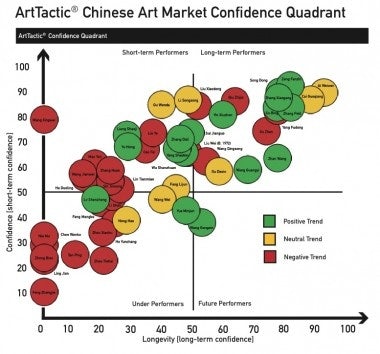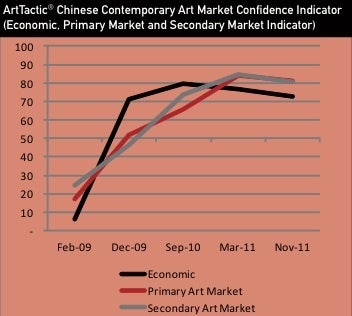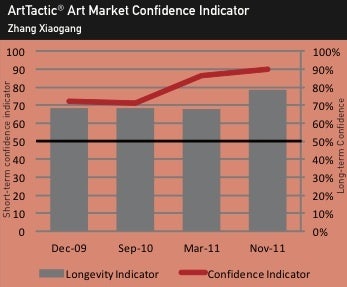"New Chinese Collectors" Continue To See Contemporary Art As Safe Asset Class#

Zeng Fanzhi and Zhang Xiaogang continue to rise, driven by interest from Chinese and international collectors
Today, ArtTactic released its latest Chinese Contemporary Art Market Confidence Survey, which, like its last survey in April, shows that confidence in the Chinese contemporary art market remains high despite an overall drop in global confidence. Buoyed by mainland China's new collectors, who have emerged as some of the world's most voracious buyers of art, gold and jewelry, and fine wine since 2008, ArtTactic's confidence indicator "remains strongly positive," though the differences between domestic Chinese and international auction houses are becoming increasingly stark. While the sustainability of the current growth rates remains suspect, a majority of respondents continue to believe the Chinese contemporary art market will grow in the next six months. What all this boils down to is the same thing Jing Daily and other market observers have said over the past two years: the Chinese contemporary art market is inevitably moving towards quality. This, perhaps more than anything, is why ArtTactic points out in this study that a gap in risk perception remains between the Hong Kong and mainland China contemporary auction markets, with the Risk Barometer for the mainland auction market coming in 49 percent higher than the international Hong Kong market. Some of the highlights of the new survey: -
Confidence in the Chinese contemporary art market remains high#
despite art market confidence dropping sharply in the US & European contemporary market in October 2011. - The recent
financial turmoil in Europe and US does not seem to have filtered down to the Chinese art market yet#
. The overall ArtTactic Chinese Art Market Confidence Indicator for November 2011 came in at 80, only 2 percent below the record reading in April 2011. - The Chinese contemporary art market has been on a "rapid path of recovery" since February 2009, and the latest reading in November 2011 indicates that
a majority of experts surveyed remain positive about the Chinese contemporary art market in the next six months#
. -
51 percent of the experts still believe the market will go up#
in the coming six months (down from 76 percent in April 2011).

While confidence is being tested by economic issues in the US & Europe, it remains far higher than two years ago
In terms of the risk projection, Hong Kong's far more internationalized auction market -- in which major auction houses like Sotheby's and Christie's can operate -- continues to garner more confidence from collectors than mainland Chinese houses like China Guardian or Poly. As Jing Daily has noted before, mainland Chinese houses promote a certain set of contemporary artists and Hong Kong promotes another, and although there are signs of overlap between the two (with certain artists, such as Zeng Fanzhi and Liu Ye proving popular in both mainland China and Hong Kong), ArtTactic notes that the Chinese contemporary art market may largely remain on a "two-track journey." In the new survey, ArtTactic's Risk Barometer for the International Chinese Contemporary Art market came in at 4.4. While this is an increase of 10 percent since April 2011, this remains below the "medium" risk level, suggesting that the current recovery is "growing at a healthy speed without strong elements of speculation." The Speculation Barometer sits at 6.4 at the upper "medium" level, but has only risen two percent since the last study this spring. For the mainland China market, naturally the proliferation of upstart, unproven auction houses has had a negative effect on ArtTactic's Risk Barometer, which currently comes in at 6.7, 49 percent higher than the International Chinese market. Still, this remains within the "upper medium" risk level. Speculation in the mainland China auction market remains a distinct concern, however, with inflows of new speculative and short-term investment capital from private, as well as institutional (art funds and investment trusts) raise concerns about the sustainability of the rapid growth of the mainland Chinese art market. What all this boils down to is that the Chinese art market recovery has attracted a great deal of "hot money," while Hong Kong is better positioned for more sustainable growth. Not a surprise, but an important trend to keep in mind. In terms of valuations, the US$50,000-100,000 price segment has seen the strongest increase in confidence over the past six months, driven mostly by the recent auction results at Sotheby's Hong Kong. This price segment, which accounted for only one percent of the total at Sotheby's Hong Kong in spring 2010, rose to seven percent of the total this autumn. While a majority of experts surveyed remain positive about the top price segment (over US$1 million), confidence has weakened in the $500,000-1 million segment.

Confidence in Zhang Xiaogang continues to rise, with the artist breaking the US$10 million mark last spring
Artist confidence remains high at the top-tier, with 67 percent of artists now having a reading above 50, indicating there is more positive than negative sentiment towards the artist's market. In the Top 10 Short-Term Confidence Ranking, Zeng Fanzhi has moved from fourth place to first, and four new entries have taken their places in the top ten: Song Dong (now second place, up from 12th), Zhang Xiaogang (fourth, up from 11th), Li Songsong (sixth, up from 15th), and Gu Wenda (eighth, up from 19th). In terms of long-term confidence, 35 percent of artists (18 out of 52) have seen a positive increase over the past six months. Among the top 10 artists that the experts believe will stand the test of time are Ai Weiwei, Cai Guoqiang, Zeng Fanzhi, Yang Fudong, Zhan Wang and Xu Zhen. ArtTactic does note that there have been some changes to the top 10 since April 2011, however, with Zhang Peili, Song Dong, Xu Bing and Zhang Xiaogang entering the list. Though several artists in these lists have seen a drop in their confidence levels since April, ArtTactic echoes what Jing Daily has said before: that a select group of blue-chip Chinese contemporary artists have firmly established themselves, and will in all likelihood remain, in the long-term performers category -- including Ai Weiwei, Cai Guoqiang, Zhang Peili, Zeng Fanzhi, Xu Bing, Song Dong , Zhang Xiaogang, and Yang Fudong. As for the collector base of Chinese contemporary art, Asian collectors continue to dominate as they have since 2008, when Western collectors cut back in the wake of the global financial crisis. Though Taiwanese collectors remain the most powerful force in the Chinese contemporary art market, one important finding in ArtTactic's new survey is that mainland Chinese "new collectors" have risen into the top five collector segments, ahead of American collectors and Indonesian collectors. Perceptions among respondents towards mainland Chinese collectors are now shifting, with ArtTactic noting that observers have largely validated the "new trend of growing interest in contemporary art from mainland China." Look for this to continue as more new collectors enter the market. As Shanghai-based "super-collector" Liu Yiqian observed this past August, "Over the past five years, there were only a few collectors involved with this market, and [I was] therefore quite familiar with buyers as well as sellers. But this situation has changed [in 2011], as half of the buyers are even new to me."
Jing Daily Conclusions#
Overall, the latest ArtTactic survey indicates that the Chinese contemporary art market (at the upper-middle to top-tier) is moving towards more sustainable growth and quality. This is very much a positive trend, and one that's absolutely necessary. As Chinese collectors continue to become more discriminating -- with many passing up lower-quality works by blue-chip artists at the recent Sotheby's Hong Kong autumn auctions -- we should see prices for many artists stabilize or trend towards slower growth. If these artists can remain insulated from the "hot money" inflows that are contributing to the myriad problems facing upstart domestic Chinese auction houses (unsustainable growth rates, issues with collecting payment, counterfeiting controversies), they will likely see their long-term confidence rankings and auction sales prices remain among the highest in the global contemporary art world. Luckily, top-tier artists like Zeng Fanzhi, Zhang Xiaogang, Fang Lijun and Yue Minjun -- who are widely sold on the internationalized Hong Kong auction market -- should see little to no ill effect from issues in the mainland China auction market.

The international and mainland China art markets are very different, but have significant crossover